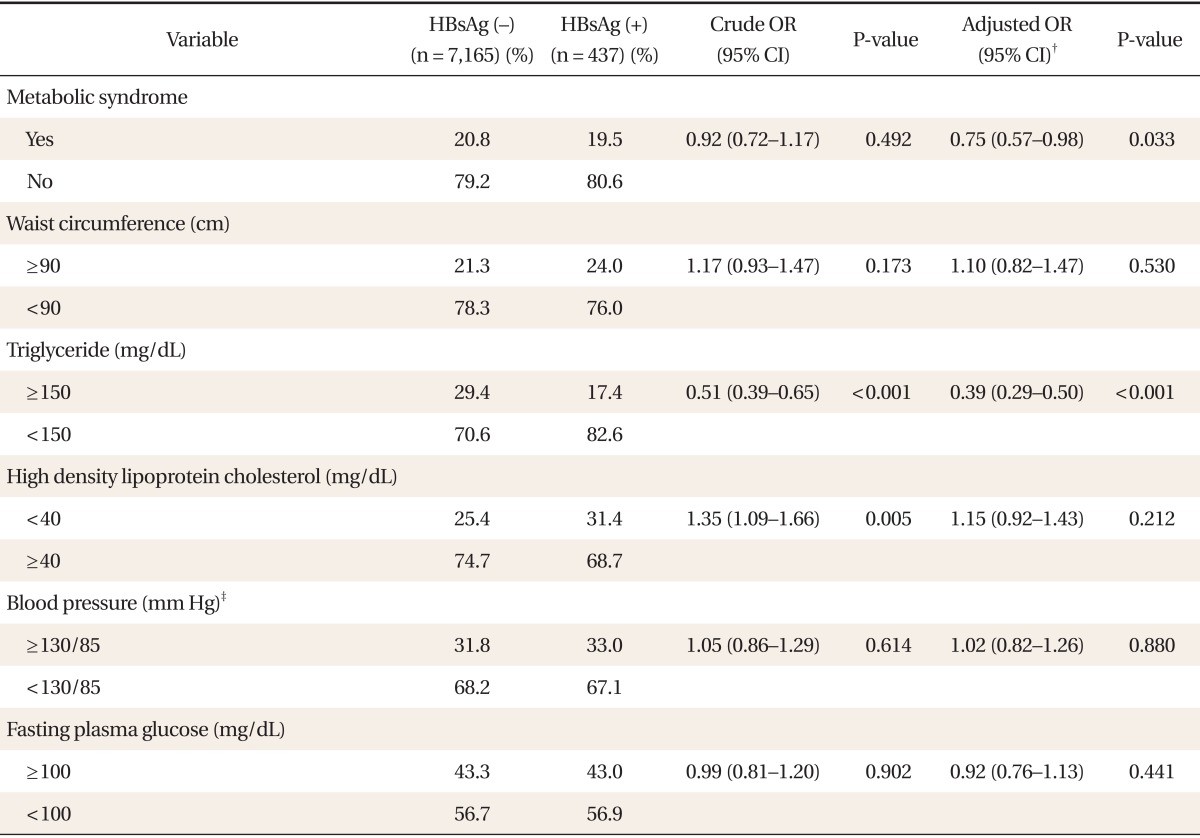1. Eckel RH. The metabolic syndrome. In: Fauci AS, Kasper DL, Longo DL, Braunwald E, Hauser SL, Jameson JL, editors. Harrison's principles of internal medicine. 17th ed. Seoul: McGraw-Hill Korea; 2008. p. 1509-1514.
2. Lim S, Park KS, Lee HK, Cho SI. Korean National Health and Nutrition Examination Surveys. Changes in the characteristics of metabolic syndrome in Korea over the period 1998-2001 as determined by Korean National Health and Nutrition Examination Surveys. Diabetes Care 2005;28:1810-1812. PMID:
15983345.


3. Dienstag JL. Hepatitis B virus infection. N Engl J Med 2008;359:1486-1500. PMID:
18832247.


4. Hui CK, Leung N, Yuen ST, Zhang HY, Leung KW, Lu L, et al. Natural history and disease progression in Chinese chronic hepatitis B patients in immune-tolerant phase. Hepatology 2007;46:395-401. PMID:
17628874.


5. Jeong S, Yim HW, Bae SH, Lee WC. Changes of hepatitis B surface antigen seroprevalence in Korea, 1998-2005. Korean J Epidemiol 2008;30:119-127.

6. Ross R. Atherosclerosis: an inflammatory disease. N Engl J Med 1999;340:115-126. PMID:
9887164.


7. Smieja M, Gnarpe J, Lonn E, Gnarpe H, Olsson G, Yi Q, et al. Multiple infections and subsequent cardiovascular events in the Heart Outcomes Prevention Evaluation (HOPE) Study. Circulation 2003;107:251-257. PMID:
12538424.


8. Gunji T, Matsuhashi N, Sato H, Fujibayashi K, Okumura M, Sasabe N, et al. Helicobacter pylori infection is significantly associated with metabolic syndrome in the Japanese population. Am J Gastroenterol 2008;103:3005-3010. PMID:
19086952.


9. Nabipour I, Vahdat K, Jafari SM, Pazoki R, Sanjdideh Z. The association of metabolic syndrome and Chlamydia pneumoniae, Helicobacter pylori, cytomegalovirus, and herpes simplex virus type 1: the Persian Gulf Healthy Heart Study. Cardiovasc Diabetol 2006;5:25PMID:
17140429.



10. Ishizaka N, Ishizaka Y, Takahashi E, Toda Ei E, Hashimoto H, Ohno M, et al. Increased prevalence of carotid atherosclerosis in hepatitis B virus carriers. Circulation 2002;105:1028-1030. PMID:
11877348.


11. Tong DY, Wang XH, Xu CF, Yang YZ, Xiong SD. Hepatitis B virus infection and coronary atherosclerosis: results from a population with relatively high prevalence of hepatitis B virus. World J Gastroenterol 2005;11:1292-1296. PMID:
15761966.



12. Volzke H, Schwahn C, Wolff B, Mentel R, Robinson DM, Kleine V, et al. Hepatitis B and C virus infection and the risk of atherosclerosis in a general population. Atherosclerosis 2004;174:99-103. PMID:
15135257.


13. Kiechl S, Egger G, Mayr M, Wiedermann CJ, Bonora E, Oberhollenzer F, et al. Chronic infections and the risk of carotid atherosclerosis: prospective results from a large population study. Circulation 2001;103:1064-1070. PMID:
11222467.


14. Luo B, Wang Y, Wang K. Association of metabolic syndrome and hepatitis B infection in a Chinese population. Clin Chim Acta 2007;380:238-240. PMID:
17316590.


15. Yen SL, Chiu TY, Lin YC, Lee YC, Lee LT, Huang KC. Obesity and hepatitis B infection are associated with increased risk of metabolic syndrome in university freshmen. Int J Obes (Lond) 2008;32:474-480. PMID:
17955029.


16. Jan CF, Chen CJ, Chiu YH, Chen LS, Wu HM, Huang CC, et al. A population-based study investigating the association between metabolic syndrome and hepatitis B/C infection (Keelung Community-based Integrated Screening study No. 10). Int J Obes (Lond) 2006;30:794-799. PMID:
16404404.


17. Frohlich ED. Recommendations for blood pressure determination by sphygmomanometry. Ann Intern Med 1988;109:612PMID:
3421573.


18. Statistics Korea. Korean Statistical Information Service. Household income and expenditure [Internet]. Daejeon: Statistics Korea; [cited 2009 Sep 20]. Available from:
http://kosis.kr/eng/
19. Genuth S, Alberti KG, Bennett P, Buse J, Defronzo R, Kahn R, et al. Follow-up report on the diagnosis of diabetes mellitus. Diabetes Care 2003;26:3160-3167. PMID:
14578255.


20. Park H. Cut-off values of waist circumference for abdominal obesity among Koreans. J Korean Med Assoc 2005;48:1165-1172.

21. Iannello S, Cavaleri A, Milazzo P, Cantarella S, Belfiore F. Low fasting serum triglyceride level as a precocious marker of autoimmune disorders. MedGenMed 2003;5:20PMID:
14600656.
22. Dai CY, Chuang WL, Ho CK, Hsieh MY, Huang JF, Lee LP, et al. Associations between hepatitis C viremia and low serum triglyceride and cholesterol levels: a community-based study. J Hepatol 2008;49:9-16. PMID:
18486265.


23. Kang SK, Chung TW, Lee JY, Lee YC, Morton RE, Kim CH. The hepatitis B virus X protein inhibits secretion of apolipoprotein B by enhancing the expression of N-acetylglucosaminyltransferase III. J Biol Chem 2004;279:28106-28112. PMID:
15123606.


24. Su TC, Lee YT, Cheng TJ, Chien HP, Wang JD. Chronic hepatitis B virus infection and dyslipidemia. J Formos Med Assoc 2004;103:286-291. PMID:
15175824.

25. Li-Ng M, Tropp S, Danoff A, Bini EJ. Association between chronic hepatitis B virus infection and diabetes among Asian Americans and Pacific Islanders. Dig Liver Dis 2007;39:549-556. PMID:
17416560.


26. Bedarida G, D'Agostino F, Bianchi M, Susani G, Sangalli F, Fattorini A, et al. Unexpected lower prevalence of HBsAg in diabetics than in controls (A study on 2,465 patients). Ric Clin Lab 1982;12:409-415. PMID:
7111984.

27. Onyekwere CA, Anomneze EE, Wali SS. Prevalence of serological markers of chronic hepatitis B virus infection in diabetics in the Lagos University Teaching Hospital, Lagos. Niger Postgrad Med J 2002;9:129-133. PMID:
12501266.


28. Wang CS, Wang ST, Yao WJ, Chang TT, Chou P. Community-based study of hepatitis C virus infection and type 2 diabetes: an association affected by age and hepatitis severity status. Am J Epidemiol 2003;158:1154-1160. PMID:
14652300.


29. Wilkins T, Zimmerman D, Schade RR. Hepatitis B: diagnosis and treatment. Am Fam Physician 2010;81:965-972. PMID:
20387772.












